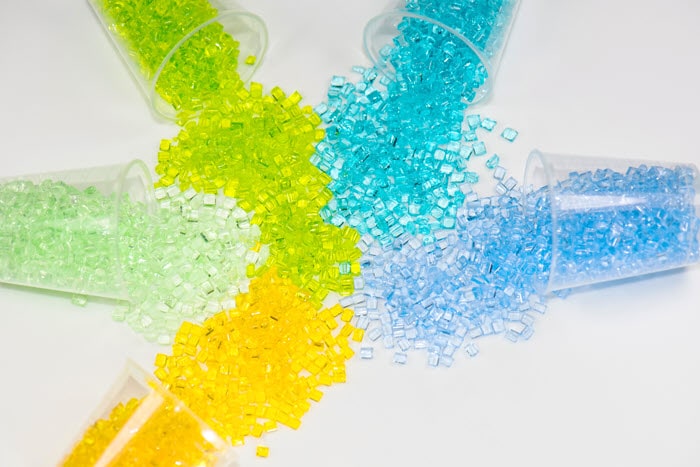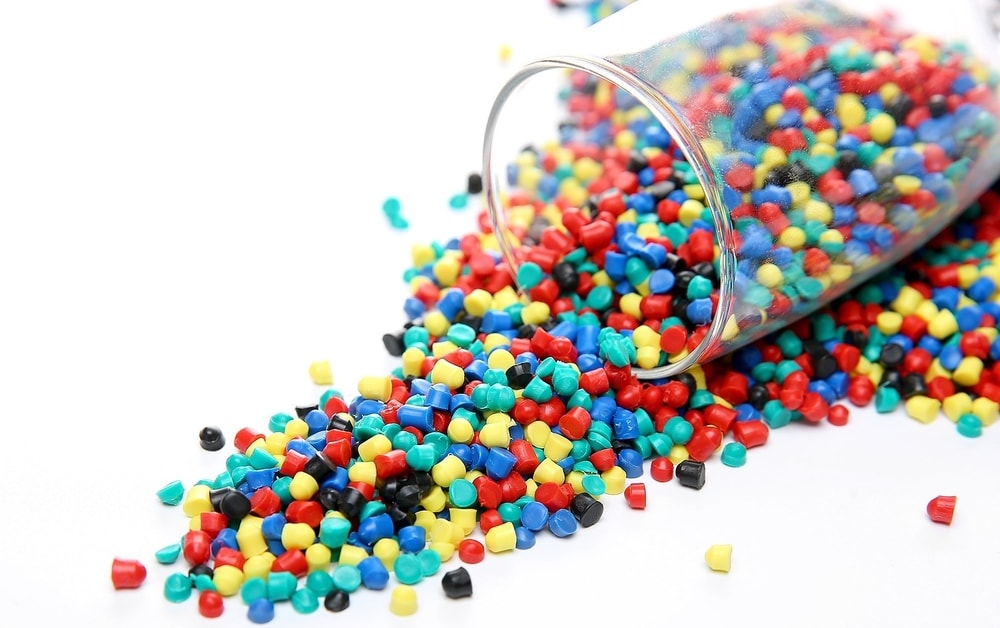BACKGROUND
A color masterbatch also known as colorconcentrate is majorly granule sized structure which has diverse usage in colouring thermoplastics. Majorly it consists of either one or more colorants along with polymer-specific carrier resin. Basically, the color masterbatch composition termed as the recipe needs to be accurate and each specific recipe for a particular color masterbatch can be customized as per customer’s requirements. The colorants can be distinguished into various types which include organic dyes, inorganic pigments as well as organic pigments. Majorly a color masterbatch consists of 60% colorant and production line processing is based on the introduction of the colorant into the melted plastic (Smink et al., 2008).
Thus the masterbatch is a solid product which is either in elastomer, plastic or rubber. The colorpigments present in high concentration in the form of additives is optimally dispersed in a carrier material. The colormasterbatch granule material has a high level of compatibility with the main plastic in which it is mixed during the melting process. Thus this is a transformative product used for plastic transformation processes and helps in subsequent value addition to plastic raw materials. The color concentrated dyes are majorly soluble in plastic and thus perfect for use in transparent colouration. Also, the coloradditive pigments remain in their original particle form when mixed with plastic and thus they need to be dispersed within the melted plastic.
Thus the concentrated mixture of pigments is encapsulated via a heat process into a carrier resin and subsequently cooled followed by cutting into a granular shape. Also, masterbatches help in providing colorraw polymer economically during the plastics manufacturing process.

FEATURES OF COLOR MASTERBATCH:
· The colormasterbatch granules are very easy to use and handle.
· It provides coloruniformity and no uneven patches on the plastic surface.
· The product has outstanding tinging power for colouring plastic surfaces.
· It has transformative features thus making value addition in plastic.
The colourant used in the product is of 2 types i.e. pigments and dyes. But dyes are generally proven to show better efficacy for colouring and possess superior properties as compared to pigments. Also, the colormasterbatch has diverse applicability in engineering plastics.
Each colormasterbatch has been classified as colourant differences via the Color Index.
TYPES OF COLOR MASTERBATCH:
The colormasterbatch varies in the type of material it is made of and the kind of suspension:
- Granulated particles in which organic pigments, inorganic pigments as well as dyes are used and have an application rate of 2-5%.
- Dry-blends are another class of colormasterbatch in which the colourants mostly used are inorganic and organic pigments. It has an application rate of 0.5-2%.
- The other class is based upon the universal nature which is the liquid form of colourant which is made of inorganic and organic pigments along with dyes. The application rate of 0.3-0.8%.
THE MAKING AND WORKING OF COLOR MASTERBATCH:
This is a plastics formulation which contains additives and is essential for the finished appearance as well as the performance of the final product. The colorant with the plastic pellets contains concentrated amounts of colorant additives. Majorly a colorconcentrate contains only specific colorants rather than additional additives which are otherwise present in an additive masterbatch (Akao et al., 2000). The colorconcentrates are either added or “let down” into the final polymer before moulding and extrusion into the finished product.
In addition to this, the exact amount of functional ingredients as well as colourants varies and is usually in a range of 0.5% – 5.0%(af-color.com, n.d.). The production of such molecules is referred to as a let-down ratio in which is a ratio of natural material to the concentrate product. Also, an important fact is that the higher the concentration of the colorant, the higher is the price of the product.
PRODUCTION OF DIFFERENT TYPES OF COLOR MASTERBATCH:
Colour, as well as the compounded colour, is majorly a product is not a final concentrate. But the colorcontains the total amount of colorants as well as other additives which will be used in the final plastic colouring product. While making a particular colormasterbatch, the moulders prefer compounded materials as it does not require the materials before processing and due to the dispersion of colorants and thus it can be more uniform.
Especially while making a colormasterbatch with the use of dye as a colorant, they are made in very light colours along with low concentrations.
Specifically, dyes are not properly dispersed and can cause colorstreaks in form of agglomerates or clumps to be seen in the final plastic product.
But the liquid colours are normal colorants which are dispersed in oils and thus have high compatibility with the final product media. Also, the colormasterbatches made of liquid colours are quite viscous and need specialized delivery systems as well as pumps for adding colours directly into the moulding as well as extrusion equipment. The liquid colours used in the colormasterbatch have an extremely high concentration of colorants.
ADVANTAGES OF USING COLOR MASTERBATCH:
- The liquid colormasterbatch is very economical after the initial purpose of the additional delivery systems required.
- Best suited for high-volume application for manufacturers who repeatedly create the same part in the same colour.
· It is easy to produce and has a quick set-up time.
· It results in massive production gain
· The chances as well as rates of failure decrease dramatically.
· It utilizes clean manufacturing processes
· Also it results in a stock reduction(www.linkedin.com, n.d.)
IDEAL COLOR MASTERBATCH FEATURES AND CUSTOMIZATIONS:

The ideally used colormasterbatch can be customized into a heavy metal-free high-performance pigment which is manufactured as per the FDA compliant pigments and utilizes eco-friendly pigments along with Infrared reflective pigments(Jian et al., 2002). This applicability of colormasterbatch varies from cosmetics packaging to extreme desert exposure.
· Also the colormasterbatch can come in a variety of options to add colorto plastic such as opaque, transparent, Phosphorescent, Sprinkle, Iridescent, Granite, Lumenedge, Sparkle, Pearl as well as Metallic and Marble coloreffects.
FAQS:
Q1: What is the colormasterbatch?
Ans: The colormasterbatch is a granular material majorly used in a combination of a masterbatch as well as a carrier material in form of a colorant (dye or pigment)solid
Q2: What is the use of colormasterbatch?
Ans: The colormasterbatch is majorly used to add colorto plastic added during moulding, the plastic and provide colorto the final plastic product without altering the properties of the masterbatch.
Q3: What are the advantages of using colormasterbatch?
Ans: Thercolormasterbatch has major applicability in terms of coloraddition to the natural polymer by use of optimum colordispersion. The greatest benefit of using color masterbatch is in colouring natural as well as base polymer instead of traditional colouring pigments or dyes compared to the pure pigment or dye.
It is much fast and convenient method of providing colorto the natural polymer. Also, the use of color masterbatch in plastic manufacturing applications is linked with low stock holding in comparison with the use of pure pigments or dyes.
Also, it provides a minimum dispersion of coloron the base. Also, a premixed colormasterbatch does not cause any no health or safety risks. Also, the colormasterbatch is dust-free.












Leave a Reply